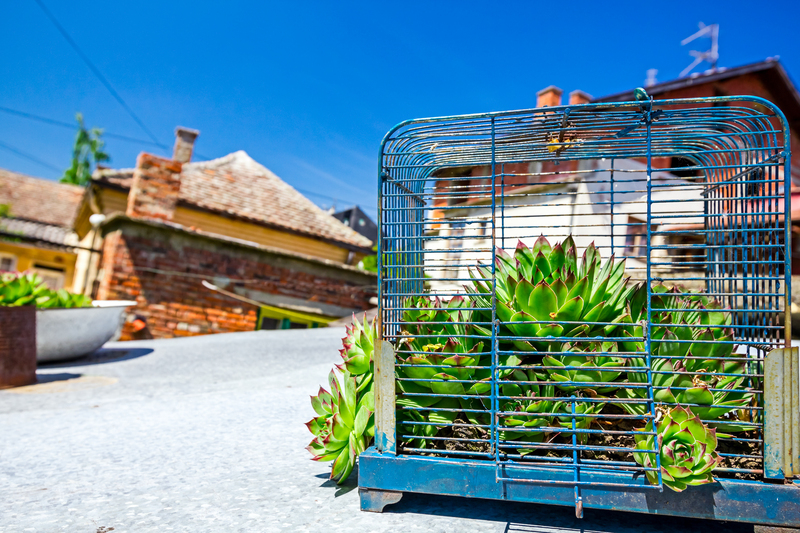Preparing Your Garden for Potential Weather Turmoil
Posted on 07/06/2025
Preparing Your Garden for Potential Weather Turmoil
Severe weather can strike at any moment, bringing heavy rain, scorching heat waves, damaging winds, or unexpected frosts. For gardeners, preparing your garden for potential weather turmoil is crucial for ensuring the survival and success of your plants. With climate patterns becoming increasingly unpredictable, understanding how to protect your green space against all odds is more important than ever.
Why Weather Preparedness Is Essential for Your Garden
Weather-related disruptions, such as storms, droughts, or sudden cold snaps, pose serious threats to the health and vitality of your plants. Unpredictable weather events not only damage crops and ornamentals but can also harm the underlying ecosystem of your garden. By preparing your garden for weather turbulence, you can:
- Reduce plant losses and protect valuable landscaping investments.
- Minimize soil erosion and nutrient loss.
- Maintain biodiversity and ecological balance.
- Increase garden resilience for future unforeseen conditions.
Understanding Local Weather Patterns
The first step in garden preparation for weather disturbances is to understand your area's historic and recent weather patterns. Consult local meteorological data, speak with longtime gardeners, and observe trends like frost dates, rainfall quantities, and wind directions. Knowing your climate zone gives you an edge in anticipating and responding to potential challenges.

Building a Weather-Ready Garden Design
Choose Resilient Plant Varieties
One of the smartest moves is to select plants suited for fluctuating weather. Look for native species, drought-resistant options, and those adapted to withstand heavy rain or temperature extremes. Some popular tough plants include:
- Lavender and sedum for drought resistance.
- Switchgrass and coneflower for enduring wind and rain.
- Daylilies and hostas for surviving sudden cold snaps.
Choosing wisely now means fewer lost plants and less heartache later.
Create Microclimates for Protection
Strategically design your garden to create small, sheltered areas--or microclimates--where sensitive plants get extra protection. Techniques include:
- Placing tall shrubs as windbreaks.
- Using fences, walls, or dense plantings to shield from prevailing winds.
- Positioning large rocks or water features to moderate temperature swings.
Microclimates can buffer against extreme heat, frost, or high winds, making a big difference during volatile seasons.
Soil Preparation: The Foundation of Garden Resilience
Resilient gardening begins below the surface. Ensuring your soil is healthy and well-structured is vital for surviving erratic weather.
- Improve drainage with compost and organic matter to reduce waterlogging during heavy rains.
- Mulch generously to retain moisture during drought and keep roots cool during heat waves.
- Aerate compacted soils to allow roots and beneficial organisms to thrive.
_A strong, living soil acts as a buffer against weather extremes--nourish it and your garden will be better equipped to handle whatever comes._
Essential Steps for Preparing Your Garden for Potential Weather Turbulence
1. Stake and Support Vulnerable Plants
Strong winds and heavy storms can topple taller or newly-planted specimens. Use stakes, cages, bamboo poles, and ties to provide support. Regularly check and adjust supports to prevent damage and ensure your plants can withstand a blast of bad weather.
2. Prune for Protection
Remove weak, dead, or diseased branches from trees and shrubs. This reduces wind resistance and prevents breakage. Proper pruning, especially in late winter or early spring, can also help plants recover quickly from storm damage.
3. Secure Your Garden Structures
Garden sheds, greenhouses, trellises, and fences are all vulnerable during severe storms. Anchoring and regularly inspecting these structures minimizes the risk of wind-driven damage. Use heavy-duty ties and ground anchors for stability.
4. Protect Against Flooding and Runoff
Floods can decimate gardens. To guard against water damage:
- Create raised beds for sensitive plants.
- Direct runoff with swales or french drains.
- Install rain barrels to capture excess water for later use.
_Managing water flow is a fundamental part of preparing your garden for potential storm damage._
5. Prepare for Extreme Heat and Drought
Increasing temperatures and longer dry periods call for special measures:
- Water deeply but less frequently to encourage deep roots.
- Add shade cloth or temporary covers on the hottest days.
- Plant drought-tolerant grasses and groundcovers to reduce evaporation.
Remember, healthy, well-mulched soil stays cooler and retains water longer, providing a buffer against heatwaves.
6. Shield from Unexpected Cold and Frost
Late spring or early autumn frosts can surprise even the most attentive gardener. Prepare by:
- Having frost blankets or horticultural fleece ready.
- Watering soil before a freeze (wet soil retains heat better).
- Bringing potted plants indoors or grouping them together for warmth.
Quick action during a cold snap can mean the difference between vibrant recovery and plant loss.
Establishing Long-Term Garden Resilience
Build Strong Root Systems
Deep, robust root systems help plants access water and nutrients during droughts and anchor them firmly during storms. Encourage strong roots by avoiding shallow, frequent watering and instead using deep soaks. Consider periodic soil amendments to boost microbe activity and root growth.
Encourage Biodiversity
A diverse garden is a resilient garden. Mix perennials with annuals, include native shrubs, plant a variety of vegetables, and invite beneficial wildlife. This broad approach creates a balanced ecosystem, reducing vulnerability to pests and the impacts of severe weather.
Embrace Permaculture Principles
Permaculture gardening is all about working with nature rather than against it. Incorporating permaculture principles involves:
- Using swales and berms to capture and redirect water efficiently.
- Planting guilds--groupings of plants that benefit one another.
- Implementing composting and natural mulches to keep soil fertile and healthy.
*Permaculture methods naturally increase your garden's capacity to handle weather upheavals.*
Emergency Preparedness: What To Do When Bad Weather Looms
Monitor Weather Alerts
Stay up-to-date with your local weather service. Use apps, radio, and emergency notifications to receive timely forecasts. Early warning allows you to take protective steps such as moving plants, securing structures, and covering vulnerable crops.
Have Supplies On Hand
Keep a stash of important materials ready for sudden weather shifts, including:
- Temporary plant covers (frost blankets, burlap, plastic sheets).
- Bamboo stakes, twine, and plant ties.
- Extra mulch or straw.
- Watering cans, buckets, and emergency irrigation supplies.
Being prepared saves time, stress, and sometimes your entire garden.
Create a Post-Storm Checklist
After the storm passes, inspect your garden methodically:
- Look for damaged plants and prune as necessary.
- Assess soil condition--repair erosion and add compost if needed.
- Check for standing water and improve drainage.
- Fix or reset any toppled structures or supports.
Prompt attention post-storm will minimize losses and encourage quicker recovery.

Frequently Asked Questions About Weather-Proofing Your Garden
How do I prepare my garden for heavy rain?
Focus on good soil drainage, raised beds, and strategic plant placement. Install rain barrels to catch runoff, and don't forget to mulch heavily to reduce soil erosion.
Can I save plants after a frost?
If frost is minor, water plants in the morning and remove any dead or damaged parts. Future frosts can be prevented with protective covers and by moving sensitive plants to sheltered locations.
What is the most weather-resistant type of garden?
A diverse, native-heavy garden with healthy soil and strategic design features (like windbreaks and raised beds) will be most resilient to any type of weather trouble.
How often should I review my garden's readiness for weather events?
Check your preparedness at least once per season. Review the condition of supports, soil health, and drainage before each anticipated period of severe weather.
Conclusion: Make Weather Turmoil a Chance for Growth
Preparing your garden for potential weather turmoil does not have to be daunting. With proactive planning, the right plant choices, and regular garden checks, your green space can thrive no matter the forecast. Not only will you safeguard your investment and hard work, but you'll also create a thriving environment ready to weather all of nature's surprises. Remember: a well-prepared garden stands strong in the face of adversity--making you a more resilient, confident gardener in the process.
By following the steps and strategies outlined above, you'll not only protect your garden from unpredictable weather events but ensure a lush, fruitful harvest and a beautiful outdoor retreat for years to come.
Further Reading:
- The Essentials of Garden Mulching
- Choosing Storm-Resistant Plants for Your Garden
- Building Raised Beds: Step by Step
Your garden can be ready for whatever the skies bring--start preparing today and watch your efforts grow, even through turmoil and challenge!

